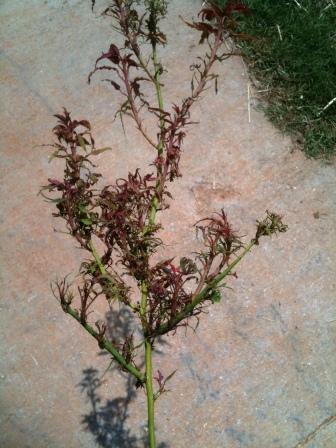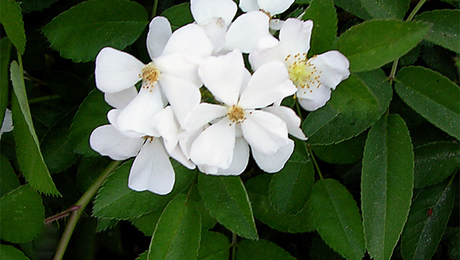
If you’ve been on some of the rose forums, attended rose talks, or even just talked roses with friends on Facebook, you’ve likely heard of rose rosette disease, or RRD. While it’s been around a while, I’ve noticed it’s starting to show up on the radar screen of more and more general gardeners. So I thought it’s time we talked about it.
First, what is it? It is a disease that is carried by a very specific spider mite, Phyllocoptes fructiphilus. An infected mite drifts on the wind, comes into your garden, lands on your roses, and then injects the disease into the rose when it starts to feed. Or a noninfected mite lands on a rose that already has it, picks it up, and then is blown by the wind to another rose, which it proceeds to infect.
You know you’ve got it when your roses start to throw off strange growth that is purplish in color and most noticeably has “foliage” in the shape of what is called “witches broom” (see photos). It actually looks a lot like Roundup damage.
 |
 |
It is particularly lethal to the species R. multiflora and in fact has been mentioned as a potential biological control method for it. R. multiflora spreads like crazy, and in much of the eastern United States it’s classified as a noxious weed. In their attempt to control it, some government officials actually facilitated the spread of RRD by purposely infecting stands of multiflora. They claim there was no scientific proof RRD infected ornamental roses, the kind you and I grow in our garden.
Well, guess what? They were flat out wrong! RRD does affect ornamental roses, although some more than others. And that is enough about how it got here. Since this is a how-to article, we now want to answer the question: What the heck can you do about it?
First, let’s talk about what you can do to reduce the likelihood of it getting into your garden. Since it hits R. multiflora quickly, check in your area for stands of that species. R. multiflora only blooms in spring with smaller white flowers that have five or so petals each. That’s the easiest time to spot it. When it’s not in bloom, the foliage helps. It’s a shiny green, and the leaves are elongated. It’s usually thornless, which really helps. It’s a rambler and so throws off long canes. Dig it up and get rid of it. That’s your first step.
If RRD does happen to infect a rose in your garden, there is no known cure. However, I’ve noticed in dealing with it that there are steps I can take. The first one is understanding how it spreads in a rose. The mites land on the top of a rose cane, where the new tender foliage is. They inject RRD into that part of the rose, and from there it slowly travels down through the cane to the base and then up the other canes. The important word here is slowly.
I’ve noticed that the symptoms on the infected cane (the witches broom) often show up before the rest of the plant is infected. So the minute I see the witches broom, I follow that cane to the base of the plant and cut it off at the base. I put it in a garbage bag and get rid of it so I don’t accidentally shake any mites onto another rose. Eventually the cut-off cane is replaced by a new one, and it’s as if nothing ever happened.
However, if the disease appears to have spread into another section of the rose, you have no choice but to dig the entire rose up and either destroy it or get rid of it via the plastic garbage bag. I’ve lost a couple, and I know others who have lost more. But once they understood what was happening and how to deal with it, the incidents became less.
So does this mean you should simply stop growing roses? Of course not! RRD is a bummer when you first get it, but by knowing how to deal with it, you can reduce it to another part of normal garden maintenance. Just keep an eye out for it, and act quickly.
For further reading, check out Ann Peck’s amazing website on RRD.
Fine Gardening Recommended Products

Pruning Simplified: A Step-by-Step Guide to 50 Popular Trees and Shrubs
Fine Gardening receives a commission for items purchased through links on this site, including Amazon Associates and other affiliate advertising programs.

Attracting Beneficial Bugs to Your Garden, Revised and Updated Second Edition: A Natural Approach to Pest Control
Fine Gardening receives a commission for items purchased through links on this site, including Amazon Associates and other affiliate advertising programs.


















Comments
Thanks for posting this. I was sure I was dealing with deer, Amarillo and snails and the purple growth was good
I sadly have four infected double knockouts. After reading about it on another forum, I have had great success with treating all four bushes with liquid zinc. I pruned the affected canes, rubbed the cut ends with liquid zinc, and have been watering them twice weekly with zinc water. I have had some new growth of witches broom, but the growth was stunted and brittle, and easily detatched from the cane at the growth point. This same cane has new groth that is perfectly healthy. Only one out of the four seems to unaffected by treatment, but it has saved the other three.
I've been treating them for a month and a half.
can u pl tell me where to get liquid zinc?
I'm not sure that all of this information is accurate. You can't get rid of a virus by pruning it out any more than you could get rid of measles by pruning off your arm. By the time an infected plant displays the traits associated with the virus that virus has already spread throughout the plant. Anyone who is "curing" a plant with RRD never had the virus in the first place and probably just had herbicide damage.
Plants don't have a circulatory system like in humans, so it may be a little bit different.
Log in or create an account to post a comment.
Sign up Log in